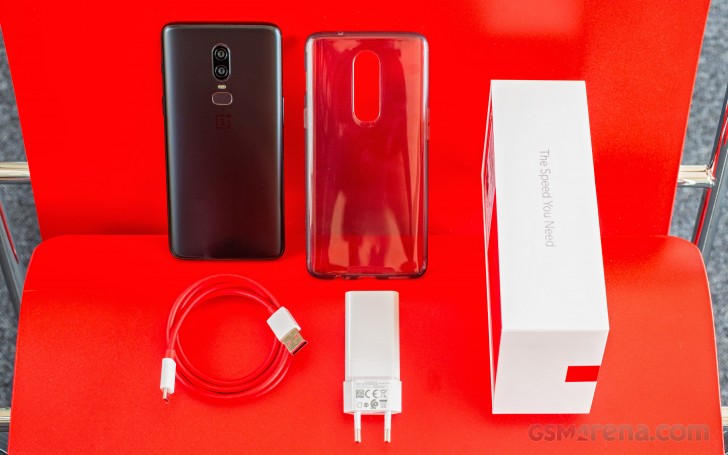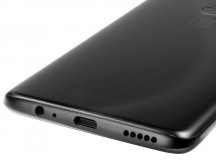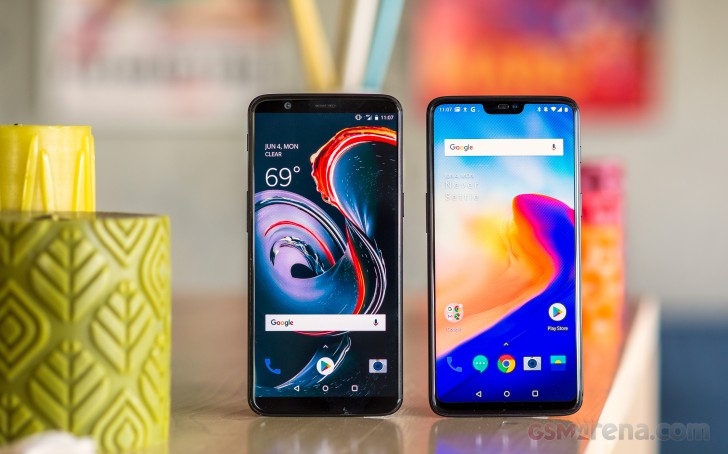OnePlus 6 review
OnePlus 6 review
technical news TEAM, 08 JUNE 2018.

Introduction
If the letter T is OnePlus' way of branding an interim half-generation upgrade, why isn't this latest one named the 5TT? Yes, we're talking about the OnePlus 6, and a quick look at the specs will tell you what we are on about. Still let's not dwell on what hasn't changed and focus instead on what has.
First off, there's a notch. The 5T brought a tall 18:9 display, the 6 takes it to the next level with a 19:9 aspect and a cutout up top for the classic phone bits. It's still AMOLED ('Optic AMOLED' OnePlus calls it), and it's still 1080px on the short side, but this time 120px more on the long end - subtracting those gone under the notch, of course.
A major design change sees the back now made of glass, but sadly no wireless charging has come with that, for those that care. There's no explicit IP rating either, though official materials and teardowns have mentioned some waterproofing measures.

The secondary camera on the back is the same and it hasn't magically started making sense to us a few months into the 5T's existence. The good news is the primary module has been upgraded - a detail you could easily miss seeing the same pixel count. The 16MP sensor is now bigger (1/2.6" vs. 1/2.8") and the bright f/1.7 aperture lens is stabilized - we'll go with 'kudos, OnePlus' instead of 'about time' since we're positive like that.
OnePlus 6 specs
- Body: Aluminum frame, glass back, 2.5D Gorilla Glass 5 display glass. Mirror Black, Midnight Black, Silk White color schemes.
- Display: 6.28" Optic AMOLED, 2,280x1,080px resolution, 19:9 aspect ratio, 402ppi; sRGB/DCI-P3 color space support.
- Rear cameras: Main camera: Sony IMX519 1/2.6" sensor, 16MP, 1.22µm pixel size, f/1.7 aperture, phase detection autofocus, OIS, EIS. Secondary camera: Sony IMX376K sensor, 20MP, 1.0µm pixel size, f/1.7 aperture. 2160p/60fps video recording, 1080p/240fps or 720p/480fps slow motion
- Front camera: Sony IMX371 sensor, 16MP, 1.0µm pixel size, f/2.0 aperture; 1080p/30fps video recording.
- OS/Software: Android 8.1 Oreo; OxygenOS custom overlay.
- Chipset: Qualcomm Snapdragon 845: octa-core CPU (4x2.7 GHz Kryo 385 Gold & 4x1.7 GHz Kryo 385 Silver), Adreno 630 GPU.
- Memory: 6/8GB of LPDDR4X RAM; 64/128/256GB UFS 2.1 storage.
- Battery: 3,300mAh Li-Po (sealed); Dash Charge proprietary fast charging (5V/4A).
- Connectivity: Dual SIM; 4-Band carrier aggregation, LTE Cat.16/13 (1024Mbps/150Mbps); USB Type-C (v2.0); Wi-Fi a/b/g/n/ac; GPS, GLONASS, Beidou, Galileo; NFC; Bluetooth 5.0.
- Misc: Rear-mounted fingerprint reader; single speaker on the bottom; 3.5mm jack; tri-position Alert Slider.
Naturally, the latest top-grade Snapdragon is in charge, with the base model OP6 packing 6GB of RAM and 64GB of storage, and you can step up to 8GB of RAM and 128/256GB of storage (the 5/5T topped out at 8/128GB). No microSD slot, of course, the OnePlus X was a one-off in this respect.
The latest-gen OnePlus phone comes with yet another price bump - once again minor, but they've been adding up. Yet, with the big players going for much bigger price hikes lately, it appears OnePlus can get away with it. Let's have a look at what you'd be getting for your bills.
OnePlus 6 unboxing
Removing the white cardboard lid reveals a red box with the phone on top. Inside, you'll find the Dash charger and cable, both of which you need if you want the ultra-fast charging. Here's the jist of it: proprietary standards - bad, 1:15h from 0% to 100% - good. Having a 3.5mm jack means no #donglelife, so that's about everything you'll find in the box - there are no earbuds bundled here.

Oh, wait - OnePlus has thrown in a soft transparent silicone case to protect that glass back. And protect the back it will, plus thanks to its raised corners on the front it will also keep your display a good millimeter away from the table surface if you're the type who leaves your phone face down. Then again, if that's the case you should probably consider speaking to someone about it - it's not natural.











Slider and power button on the right • OP6 takes two nano SIMs • USB-C, headphone jack, mic and speaker


the switch to glass even if our review unit might be giving off an aluminum vibe. It goes by 'Midnight black' in OnePlus speak and it has been achieved through corrosion of the glass, creating tiny holes. The end result is that it looks a lot like the old 5T.

It doesn't quite feel like it, though - it's even more slippery. We'd go so far as to say it's among the most slippery phones we've held on to - or rather, worked hard to hold on to. The bundled silicone case sure helps provide some security, taking away from the looks in the process.

The glossy-as-you'd-expect Mirror Black version should be easier to keep safe, though inevitably much more prone to accumulating fingerprints. That's the real upside of the matte finish - it stays looking clean. The Silk White is closer in feel to the Midnight Black than it is to the Mirror one.
Moving on, the OnePlus 6 marks a return to the center-mounted camera after the 5 and 5T's fling with a top left corner position. Now everything is along the same axis - the flash is below the camera, the fingerprint reader under them, and last - a 1+ logo. Simple, clean and tidy.

We have this one little complaint - perhaps a little more depth could have given your fingers some more tactile clues where to find the sensor. As it is, it's a bit too flat, and takes some getting used to. The case does give it more definition, but even without it you'd get used to after some time.

A couple of things we've come to associate with glass-backed phones are wireless charging and dust and water resistance. Well, the OnePlus 6 doesn't do the former, and doesn't have an official IP rating. It does say on its website that the phone should be fine in the rain, though OP is quick to advise against submersion. We'd imagine the company wants to avoid the customer service and publicity nightmare that a drowned OP6 could bring.
Anyways, over on the front there's the 6.28-inch AMOLED display, complete with rounded corners and a notch. Inside the notch OP has fitted all the usual top-bezel stuff - the earpiece, camera, ambient light and proximity sensors are here, as is a notification LED, yay!

Why is there a notch up top, if there's a bezel on the bottom, you can hear us mumble even though at this point we've come to accept the fad. Whatever's happening under the display, it's underneath the surface, there's nothing to see on the chin.

The back may be made of glass, but the frame is still aluminum. It's here that one of the major changes in handling is between the OnePlus 6 and all previous generations - the alert slider has been moved to the right side.

We imagine the vast majority of people use their phones with the right hand, so it probably makes sense. For the phone-lefties, however, that means a lot of effort to use the slider with the index finger. Here's one reviewer who insists he isn't a total klutz, contemplating about the four times he almost dropped the OP6 trying to switch the slider to silent.

The right is the side where you'll find the power button - no changes here. The volume rocker is on the left, and above it, right where the slider used to be, is the SIM card slot.
There's a lot of important stuff on the bottom. The USB-C port is in the center with a loudspeaker to one side, and the 3.5mm jack and the primary mic on the other. A secondary mic can be found on top.



Slider and power button on the right • OP6 takes two nano SIMs • USB-C, headphone jack, mic and speaker
The OnePlus 6 measures 155.7 x 75.4 x 7.8mm - 0.4mm taller, 0.4mm wider and 0.5mm thicker than the model it replaces - all negligible differences. It is, however, 15g heavier than the 5T and we blame the glass. Not that 177g is unmanageable or anything.
In fact, the Galaxy S9+ is even heavier (189g) and so is the Huawei P20 Pro, if only marginally so (180g). The Galaxy is also a couple of mm taller while the Huawei flagship is virtually identical in size to the OP6.

A notched iteration of Optic AMOLED
The OnePlus 6 has a 6.28-inch display of a 19:9 aspect ratio that accommodates a notch up top. The resolution is 1,080 x 2,280px and that makes for a 402ppi pixel density. It's an AMOLED panel, which OnePlus likes to call Optic to differentiate it from others on the market. Plus, you can't spell Optic without OP.

In our testing, the OnePlus 6 posted a maximum brightness of 456nits, a small bump over the 5 and 5T. Just like them, there's no brightness boost when in auto mode. The Galaxy S9+ is a lot brighter with auto enabled, but is dimmer when you're moving the slider yourself. Even the far from perfect LG V30 screen can push out upwards of 600nits in auto mode. The Huawei P20 Pro's non-Optic AMOLED can also go above 600nits. The Pixel 2 XL, on the other hand, is behind the OnePlus 6 in maximum brightness and has no auto boost either.
| Display test | 100% brightness | ||
| Black, cd/m2 | White, cd/m2 | ||
| 0 | 435 | ∞ | |
| 0 | 437 | ∞ | |
| 0 | 456 | ∞ | |
| 0.392 | 530 | 1352 | |
| 0.471 | 621 | 1318 | |
| 0 | 420 | ∞ | |
| 0.176 | 287 | 1631 | |
| 0.431 | 618 | 1434 | |
| 0 | 376 | ∞ | |
| 0 | 631 | ∞ | |
| 0 | 412 | ∞ | |
| 0 | 582 | ∞ | |
| 0 | 410 | ∞ | |
| 0.375 | 453 | 1208 | |
| 0.409 | 519 | 1269 | |
| 0.002 | 414 | 207000 | |
| 0.032 | 616 | 19250 | |
| 0.382 | 703 | 1840 | |
| 0 | 400 | ∞ | |
| 0.002 | 600 | 300000 | |
In our sunlight simulation test, the OnePlus 6 posted a lower score than the OP5T, but then the 5T has the second-best result in the modern era. Despite the drop, the OP6's contrast under direct light is still excellent, almost Galaxy S9+ excellent, and better than the likes of Huawei P20 Pro, LG V30, and Nokia 8 Sirocco.
Sunlight contrast ratio
- Apple iPhone X5.013
- OnePlus 5T4.789
- Samsung Galaxy S9+4.537
- OnePlus 64.321
- Oppo R15 Pro4.251
- Nokia 84.239
- Google Pixel 2 XL4.234
- Huawei P20 Pro4.087
- LG V304.022
- OnePlus 53.914
- Nokia 8 Sirocco3.745
- Sony Xperia XZ23.58
- HTC U11+ (EU)2.253


Comments
Post a Comment